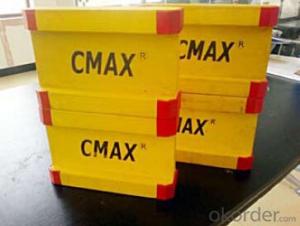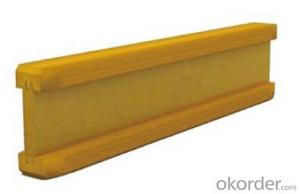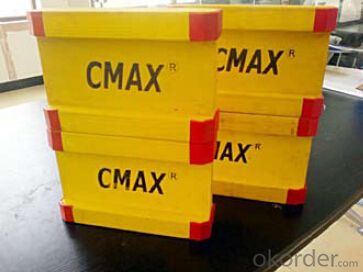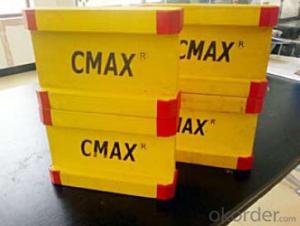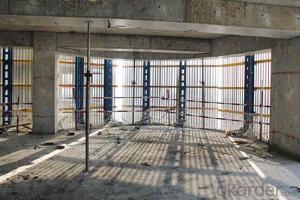Timber-Beam for Formwork and scaffolding system
- Loading Port:
- Tianjin
- Payment Terms:
- TT OR LC
- Min Order Qty:
- 50 m²
- Supply Capability:
- 1000 m²/month
OKorder Service Pledge
OKorder Financial Service
You Might Also Like
Characteristics:
◆ Standardized production lines.
Supply capability: 3000m/day, Lmax = 6600mm.
◆ Finger jointing of the flange and web, the strength of timber beam is highly improved.
Max. shearing force failure load:40KN
◆ Well treated to prevent from water penetration or erosion, so the service life maximally extended.
Normally, CNBM timber beam H20 can be used for 4 to 5 years, the exact using time would depend on maintenance & storage.
◆ Robust caps at the end of the girders protect against damages.
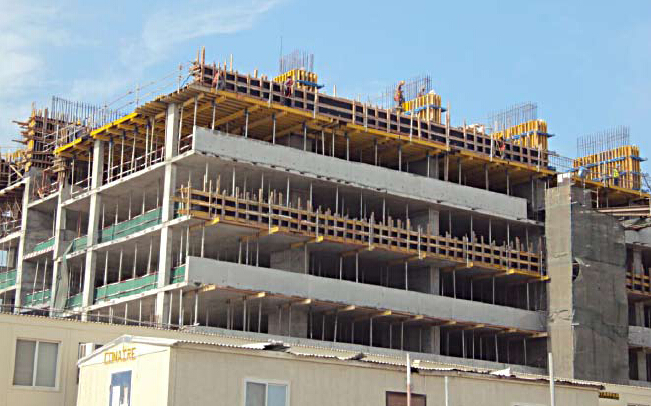
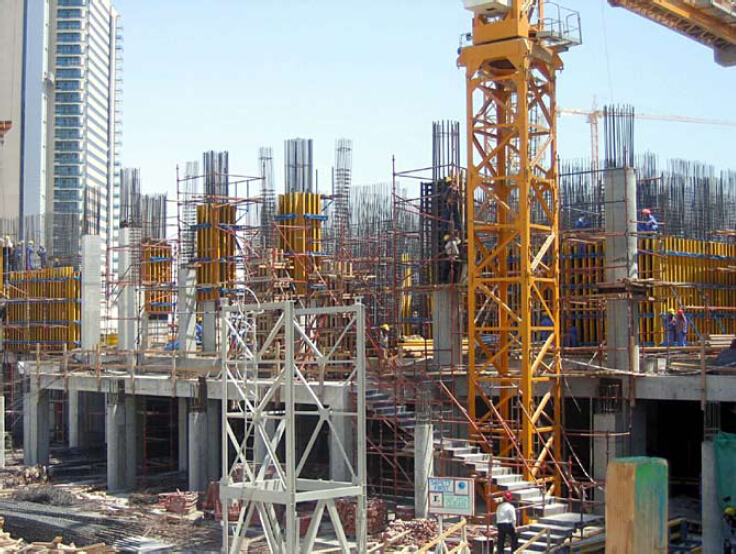
- Q: Can steel formwork be used for both single-sided and double-sided forming?
- Yes, steel formwork can be used for both single-sided and double-sided forming. It is a versatile and durable material that can withstand the pressure and weight of concrete on both sides, making it suitable for various construction applications.
- Q: What are the common design considerations for steel formwork systems?
- To ensure a successful construction project, it is important to take into account several design considerations for steel formwork systems. First and foremost, the load-bearing capacity of the steel formwork system is crucial. It must be able to safely support the weight of the poured concrete as well as any additional loads like workers and equipment. Calculations and analysis are necessary to determine the appropriate thickness and reinforcement of the steel formwork. In addition, the formwork system should be designed to provide sufficient stability and resistance against lateral forces. This is especially important for tall or complex structures that may be subject to significant wind or seismic loads. The design should incorporate bracing and anchorage systems to ensure stability throughout construction. Another important consideration is the ease of assembly and disassembly of the steel formwork system. The design should facilitate efficient installation and removal, minimizing labor and time requirements. This can be achieved through the use of modular components and standardized connections that are easy to assemble and dismantle. Furthermore, the formwork system should be adaptable to any necessary adjustments or modifications. Construction projects often require changes during the process, and the formwork should be flexible enough to accommodate these changes without compromising its structural integrity. Safety is also a crucial aspect in the design of steel formwork systems. The formwork should provide a safe working environment for construction workers, incorporating features like handrails, access platforms, and non-slip surfaces. Additionally, potential hazards such as sharp edges or protruding elements should be considered, and appropriate safety measures should be incorporated to mitigate these risks. Lastly, the durability and longevity of the steel formwork system should be taken into consideration. It should be designed to withstand the harsh conditions of construction, including exposure to weather, chemicals, and repeated use. This may involve the use of corrosion-resistant materials or protective coatings to ensure the longevity and performance of the formwork system. In conclusion, there are several important design considerations for steel formwork systems, including load-bearing capacity, stability against lateral forces, ease of assembly and disassembly, adaptability to changes, safety features, and durability. By carefully considering these factors, engineers can design a steel formwork system that meets the specific requirements of a construction project and ensures its successful execution.
- Q: How does steel formwork handle concrete pumping and placing?
- Steel formwork is an incredibly strong and versatile construction material that is perfect for dealing with the pumping and placing of concrete. Its robustness and rigidity mean that it can withstand the pressure exerted by the concrete during the pumping process without any distortions or failures. This provides a stable and secure framework, ensuring that the concrete is placed and consolidated accurately. Furthermore, steel formwork offers exceptional resistance to the abrasion and corrosion caused by concrete. This is particularly crucial during the pumping and placing stages, as the concrete is often mixed with various additives and can have a high alkaline content, which can be destructive to other types of formwork materials. However, steel formwork remains unaffected by these chemical reactions, making it a dependable choice for handling concrete pumping and placing. Moreover, steel formwork is incredibly adjustable and adaptable, allowing for the creation of intricate shapes and designs. It can be easily assembled and disassembled, enabling efficient and swift reconfiguration of the formwork system to accommodate different concrete pumping and placing requirements. This flexibility makes steel formwork the preferred choice for projects that involve complex or customized concrete structures. Additionally, steel formwork provides a smooth and uniform surface finish to the concrete, guaranteeing that the final structure meets the desired aesthetic and functional requirements. The rigid nature of steel formwork helps prevent any distortions or irregularities in the concrete surface, resulting in a high-quality and visually appealing end product. In conclusion, steel formwork is the ideal option for handling concrete pumping and placing due to its strength, durability, resistance to chemical reactions, adaptability, and ability to provide a smooth finish. It offers a reliable and efficient solution for construction projects that require accurate and precise concrete placement.
- Q: What are the different types of connections used in steel formwork systems?
- There are several types of connections used in steel formwork systems, each serving a specific purpose. The most common types of connections are as follows: 1. Bolted Connections: This type of connection involves using bolts to join different components of the steel formwork system. Bolted connections are strong and rigid, providing stability and ensuring that the formwork remains intact during the concrete pouring process. 2. Welded Connections: Welding is another commonly used method for connecting steel formwork components. Welded connections offer excellent strength and durability, and they can withstand heavy loads and vibrations. Welding also allows for a seamless connection, reducing the risk of leakage or seepage of concrete. 3. Pin Connections: Pin connections involve using steel pins to connect different formwork components. These pins are inserted into pre-drilled holes and secured with nuts or other fasteners. Pin connections are relatively easy to assemble and disassemble, making them suitable for temporary formwork systems. 4. Clamped Connections: Clamped connections utilize clamps or couplers to connect various steel formwork elements. Clamps are typically tightened with bolts or screws to provide a secure connection. This type of connection is often used in systems where quick assembly and disassembly are required. 5. Interlocking Connections: Interlocking connections involve using interlocking mechanisms or slots to connect different formwork components. These connections are designed to fit together seamlessly, providing stability and preventing any movement or displacement during the concrete pouring process. Interlocking connections are often used in modular formwork systems. Each type of connection has its advantages and disadvantages, and the choice of connection method depends on factors such as the formwork system design, load requirements, assembly/disassembly speed, and project specifications. It is crucial to select the appropriate connection type to ensure the safety and efficiency of the steel formwork system.
- Q: How does steel formwork contribute to the overall sustainability of the construction industry?
- There are several ways in which steel formwork contributes to the overall sustainability of the construction industry. Firstly, its durability and long-lasting nature allow for multiple reuses, reducing the need for new formwork materials each time a construction project is undertaken. This, in turn, significantly reduces waste generation during the construction process and minimizes the industry's overall environmental impact. In addition, steel formwork offers a more sustainable alternative to traditional materials like timber. The use of timber often involves cutting down trees, leading to deforestation and habitat destruction. By opting for steel formwork, we can decrease our reliance on timber and contribute to the preservation of forests. Moreover, steel formwork provides greater structural stability and strength compared to other materials. This enables more efficient construction processes and reduces the necessity for additional support structures. Consequently, less material is wasted, energy is conserved, and the overall construction time is shortened, resulting in a more sustainable process. Furthermore, steel formwork exhibits exceptional resistance to weather conditions, corrosion, and fire. This ensures the longevity of buildings, thus reducing the need for frequent repairs or replacements. By utilizing steel formwork, we can construct structures with extended lifespans, leading to reduced resource consumption and waste generation over time. Lastly, steel formwork is recyclable. At the end of its lifecycle, it can be easily melted down and repurposed for other applications. This diminishes the demand for new steel production, conserves natural resources, and lowers energy consumption. To sum up, steel formwork's durability, reusability, resistance to weather conditions, and recyclability all contribute to the overall sustainability of the construction industry. By minimizing waste generation, deforestation, energy consumption, and resource depletion, its use proves to be an environmentally-friendly choice for construction projects.
- Q: How does steel formwork accommodate openings and penetrations in the concrete?
- Openings and penetrations in concrete can be accommodated by steel formwork through different methods. One popular method involves the use of prefabricated steel form panels with pre-cut openings or penetrations. These panels can be easily assembled and aligned to achieve the desired shape and size of the concrete opening or penetration. Another approach utilizes adjustable steel formwork systems that provide flexibility in creating openings and penetrations. These systems often consist of modular components that can be adjusted or rearranged to fit various shapes and sizes of openings or penetrations. Removable form inserts or sleeves are also employed in certain cases. These inserts or sleeves are placed within the formwork during concrete casting and later removed once the concrete has set, leaving behind a void or opening. Moreover, steel formwork can incorporate different accessories like hinged or sliding formwork elements. These accessories can be adjusted to create openings or penetrations, offering additional flexibility to accommodate diverse design requirements. In summary, steel formwork is highly versatile in accommodating openings and penetrations in concrete construction due to its strength, durability, and ease of adjustment or modification to meet specific project needs.
- Q: Does steel formwork require any special training or expertise for installation?
- Yes, steel formwork does require special training and expertise for installation. Steel formwork is a complex system that is used in concrete construction to create temporary molds or frameworks. The installation process involves assembling and fixing the steel panels, beams, and other components in a precise manner to ensure the desired shape and strength of the concrete structure. Proper installation of steel formwork requires knowledge of construction techniques, understanding of engineering principles, and familiarity with the specific design and requirements of the project. It also involves expertise in reading technical drawings, interpreting structural plans, and accurately calculating the dimensions and quantities of the steel formwork components. Furthermore, the installation process may involve the use of heavy machinery, such as cranes or lifting equipment, to position and secure the steel formwork. Handling and operating such equipment require specialized training to ensure safety and efficiency. Improper installation of steel formwork can lead to structural weaknesses, compromised concrete quality, and safety hazards. Therefore, it is essential to have trained professionals who have the necessary skills and experience to handle the installation process effectively. In conclusion, due to the technical nature and importance of steel formwork in concrete construction, special training and expertise are required for its installation. Hiring qualified professionals with the necessary knowledge and skills ensures the successful implementation of the formwork system, resulting in safe and high-quality concrete structures.
- Q: What are the considerations when selecting the appropriate formwork system for a project?
- Some considerations when selecting the appropriate formwork system for a project include the complexity and size of the structure, the required quality and finish of the concrete, the project timeline, the available budget, the construction site conditions, and the desired level of reusability and sustainability of the formwork system. It is also important to consider the expertise and skill level of the construction team, as well as the safety features and ease of assembly and dismantling of the formwork system.
- Q: What is the weight of steel formwork panels?
- The weight of steel formwork panels can vary depending on their size and thickness. On average, a standard steel formwork panel might weigh between 50 to 70 kilograms (110 to 155 pounds).
- Q: How does steel formwork affect the overall safety of a building project?
- Steel formwork plays a crucial role in enhancing the overall safety of a building project. Firstly, steel formwork is known for its high strength and durability, which ensures a stable structure during the construction process. This stability is essential in preventing accidents such as collapses or structural failures that can cause serious injuries or fatalities. Moreover, steel formwork provides a secure and reliable platform for workers to perform their tasks. The rigid structure minimizes the risks of slips, trips, and falls, which are common causes of accidents on construction sites. Additionally, steel formwork can be designed to include safety features such as handrails, guardrails, and non-slip surfaces, further enhancing worker safety. Another significant advantage of steel formwork is its fire-resistant properties. Steel is non-combustible, meaning it does not contribute to the spread of fire. This characteristic significantly reduces the potential for fire-related accidents in a building project, safeguarding both the workers and the structure itself. Furthermore, steel formwork is highly resistant to adverse weather conditions, such as heavy winds, rain, or earthquakes. This resistance ensures that the structure remains stable and secure even during extreme weather events, minimizing the risks of accidents or damage caused by these external factors. Lastly, steel formwork offers better quality control compared to other types of formwork materials. The precise and consistent dimensions of steel formwork reduce the chances of errors or inconsistencies in the construction process, resulting in a safer and more reliable end product. In conclusion, steel formwork positively impacts the overall safety of a building project by providing stability, a secure working platform, fire resistance, weather resistance, and improved quality control. These factors collectively contribute to reducing the risks of accidents, injuries, and structural failures, making steel formwork an essential component in ensuring a safe construction environment.
Send your message to us
Timber-Beam for Formwork and scaffolding system
- Loading Port:
- Tianjin
- Payment Terms:
- TT OR LC
- Min Order Qty:
- 50 m²
- Supply Capability:
- 1000 m²/month
OKorder Service Pledge
OKorder Financial Service
Similar products
Hot products
Hot Searches
Related keywords
